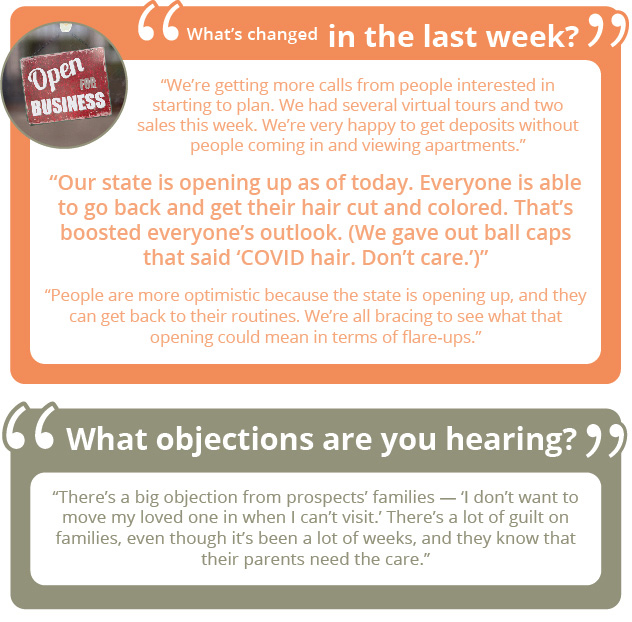Today’s blog is a guest post by Michael Whitlow, MBA, senior regional manager, sales & marketing services division at Greystone Communities, on giving virtual tours. Previous to his time at Greystone, Michael worked in a broad range of related industries, including pharmaceutical, senior living and home health.
I’d like to share some tips on giving virtual tours that started with a webinar I gave.
A little background: When the situation with COVID-19 started, our company very quickly began to do Zoom calls, and everyone said, “We need to ask your sales teams to do virtual tours because of the restrictions at communities.” But what’s worse than doing a virtual tour? Doing a bad one. That’s where the idea for the webinar began.
The reason it’s critical to pay attention to the virtual medium is that, based on statistics I’ve heard, about half of senior living communities are not doing any virtual events or touring. This opens this area up for those who are doing them to get ahead of the game.
Statistics also show that 80% of communities that are doing virtual events are not doing them well. There’s a big opportunity to stand out from the competition by doing excellent virtual tours.
These tips and talking points might seem silly, but following them really makes for a better experience. You have to pay attention to the small things. Here are some tips for a successful virtual tour:
- Get buy-in to the tour beforehand
- Be a resource: If the person expresses nervousness about using technology, it gives you the opportunity to say, “Let me teach you how to do this. I’ll be glad to walk you through it so you can use it with your family and friends.” That way, you’re being of value and are a trusted resource.
- Show empathy: You can say, “Hey, I’d love for you to see me and me to see you and show you our community.” Be friendly and empathetic.
- Use FaceTime for ease of use and connection with your prospect (assuming both have Apple devices) If not, click here for a list of suggestions:
- Invest in a stand and Steadicam attachment
- Test out the best ways to use the camera.
- Film from above.
- Don’t stand in front of a light source.
- Don’t put the camera too close to your face.
- Look at the camera, not your picture.
- Have a plan
- Create an outline — it’s easy to get lost when standing in front of the lights.
- Plan and trial run the tour route.
- Keep handy a FAQ sheet and information on features and benefits.
- You never want to walk away from the camera to get your notes; have them close by.
- Role-play a live tour first
- It’s time to shine!
- “Sit, tour, sit” still applies, but location may vary.
- When not touring, secure your camera. (Use a tri-pod, prop it up with books, etc. You don’t want a lot of movement so the person watching loses focus.)
- While touring, stick with one view.
- Keep the camera facing away from you.
- Slow down: Pause for 3–5 seconds before moving to a new view.
- Be smooth.
- Postproduction
- Blend “new school” with “old school.”
- Handwritten letters as a follow-up are really welcomed right now.
- Don’t forget the process: “sales cycle.”
- You aren’t just doing a fun little tour; you are moving people through the same sales process you normally would. This is a selling tool, not “I’m going to show you something fun and then let you go.”
- If it’s not in the CRM, it didn’t happen!
- Virtual tours need to be part of our new normal. Like any part of the sales cycle, the tour should go right into the CRM, with a full write-up.
- Tips during the discussion
- Avoid showing residents. Prospects want to see public spaces and apartments.
- How long? Ask the people up front if they have 15–20 minutes for the tour.
- Prepare a video you can share separately.
- If you’re working from home, it’s still good to have a video discussion. You could have somebody in the community take footage and share it with you.
- Results
- In a short period of time, people are getting strong results. Two of the communities I work with took a deposit after a virtual tour last week.
- What’s next?
- Whoever starts to deal with the current environment really well right now is going to have an advantage. Virtual tours are a great selling tool that you can continue to use even after coronavirus. Here are some things your community can do to stay ahead:
- Make sure you have a Steadicam ready to go.
- Train all employees to do virtual tours.
- Bring a family member who lives far away into the decision process by including them in a virtual tour with the prospect.
- Find new applications for virtual technology:
- Use it to communicate with your vendors.
- Give virtual tours of your community over lunch hours to busy social workers, nurses and physicians.
Remember: The more tools you have for selling, the better. Again, since only half of communities are using virtual events, and only 20% of those are doing them well, this is your opportunity to get out in front of your competition. Take advantage of it.
About Greystone
Greystone has been a recognized leader in senior living consulting for over 35 years. The organization works with more than 500 owners and sponsors in more than 46 states and manages 50+ communities. Learn more about Greystone.






